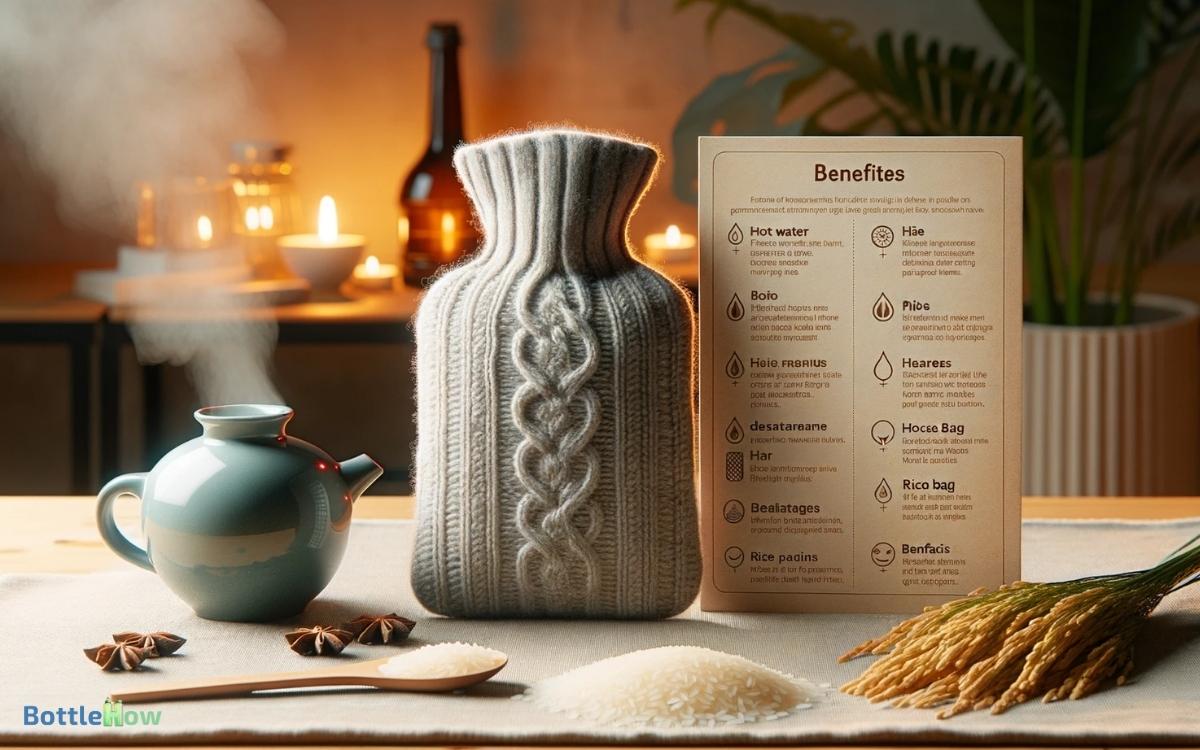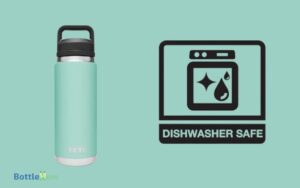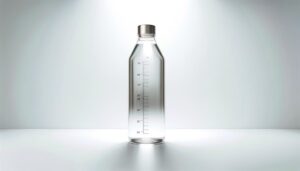Hot Water Bottle Vs Rice Bag: Side By Side Comparison!
When comparing hot water bottles and rice bags, each has unique advantages. Hot water bottles retain heat longer, lasting up to six hours, but they need careful handling to avoid burns and leaks.
Rice bags are more flexible and easier to use since they can be microwaved, yet they lose heat faster—typically within one to two hours.
Additionally, rice bags are more eco-friendly and budget-friendly than hot water bottles. Both options are widely available, but each has different safety considerations and maintenance needs.
For a more thorough understanding of their differences and suitable uses, continue to explore further details.

Key Takeaways
Heat Retention
When comparing heat retention, you’ll find that hot water bottles generally maintain their warmth longer than rice bags.
Research indicates that hot water bottles can retain heat for up to six hours. This is due to water’s high specific heat capacity, meaning it can store more thermal energy.
In contrast, rice bags typically lose their heat within one to two hours. Studies suggest that rice, being a dry material, doesn’t hold heat as effectively as water. Additionally, the insulating properties of the rubber or silicone material of hot water bottles contribute to their superior heat retention.
If your priority is prolonged warmth, a hot water bottle is a more effective choice compared to a rice bag.
Ease of Use
Aside from heat retention, ease of use is another critical factor to take into account when choosing between a hot water bottle and a rice bag.
Here are four important aspects to take into consideration:
- Preparation Time: A hot water bottle requires boiling water, while a rice bag just needs a microwave.
- Portability: Rice bags are often more flexible and can conform to different body parts, whereas hot water bottles are more rigid.
- Maintenance: Hot water bottles need to be emptied and dried after each use, but rice bags can be stored directly after cooling.
- Availability of Materials: A hot water bottle needs a specific container, whereas a rice bag can be made from common household items.
These points highlight the practical differences in ease of use.
Safety Considerations
Evaluating the safety considerations of hot water bottles versus rice bags is essential to ensure you avoid potential hazards. Evidence shows that both have unique risks.
Hot water bottles can scald if the water is too hot or the bottle leaks. Conversely, rice bags, if overheated, can cause burns or even catch fire if not properly monitored.
| Safety Aspect | Hot Water Bottle | Rice Bag |
|---|---|---|
| Risk of Burns | High if water is too hot | High if overheated |
| Leakage Potential | Moderate, due to possible material failure | Low, as there is no liquid involved |
| Fire Hazard | Low, non-flammable material | Moderate, risk if overheated |
| Durability | High, if quality material used | Moderate, can wear with repeated use |
| Reusability | High, with proper maintenance | High, if not overheated frequently |
Cost and Availability
When considering cost and availability, you’ll find that the initial purchase price of hot water bottles and rice bags can vary to a large extent.
Hot water bottles are generally more durable and reusable, potentially offering better long-term value.
Additionally, both options are widely accessible in stores, although the availability of specific types may differ based on your location.
Initial Purchase Price
Comparing the initial purchase price, you’ll find that hot water bottles generally cost between $10 to $20, while rice bags can be made at home for just a few dollars. This makes rice bags more accessible and budget-friendly if you’re looking to minimize costs.
Let’s break it down further:
- Hot Water Bottle Price Range: $10 to $20.
- Rice Bag Materials Cost: Approximately $3 to $5 (fabric and rice).
- Availability: Hot water bottles are readily available in stores and online.
- DIY Option for Rice Bags: Easily made at home with minimal materials.
Research indicates that the affordability and DIY nature of rice bags provide a cost-effective solution compared to purchasing a commercially-made hot water bottle.
Reusability and Durability
While both hot water bottles and rice bags offer reusable options, their durability varies greatly based on material quality and usage frequency.
Hot water bottles, typically made from rubber or thermoplastic, can last several years if used and stored correctly.
On the other hand, rice bags, often made from fabric and filled with rice, might need more frequent replacement due to wear and tear.
Here’s a quick comparison:
| Feature | Hot Water Bottle | Rice Bag |
|---|---|---|
| Material Durability | High | Moderate |
| Lifespan | 2-5 years | 1-3 years |
| Maintenance | Low | Medium |
| Replacement Cost | Low | Low |
Understanding these differences helps you make an informed decision based on your needs and usage patterns.
Accessibility in Stores
You’ll find that both hot water bottles and rice bags are widely available in most stores and online platforms, often at affordable prices.
When considering cost and availability, it’s worth mentioning:
Hot Water Bottles: Frequently found in pharmacies, supermarkets, and specialty stores. Prices range from $10 to $30, depending on quality and brand.
Rice Bags: Typically available in DIY kits or pre-made in health stores and online, usually costing between $5 and $20.
Online Shopping: Both items are readily available on major e-commerce platforms like Amazon, often with user reviews to guide your choice.
Seasonal Availability: Hot water bottles may be more prominent in colder months, while rice bags are generally available year-round.
This accessibility ensures you can easily obtain either option as needed.
Environmental Impact
Evaluating the environmental impact of hot water bottles and rice bags reveals notable differences in their production, use, and disposal.
Hot water bottles are often made from rubber or PVC, materials that require energy-intensive extraction and manufacturing processes. Additionally, their disposal poses challenges due to non-biodegradable components. This environmental impact has led many to seek sustainable alternatives, such as reusable cloth covers or repurposed containers. Proper diy water bottle storage solutions can also help extend the lifespan of these bottles, reducing waste over time. Exploring eco-friendly materials, like silicone or recycled rubber, may further minimize their environmental footprint.
On the other hand, rice bags utilize natural materials—commonly rice and fabric—which are biodegradable and often sourced more sustainably.
You can reuse a rice bag multiple times, and when it’s time to discard it, the environmental footprint is considerably lower.
However, the energy needed to heat a rice bag may offset some of its benefits. Comparing these options, rice bags generally exhibit a smaller ecological footprint, making them a more eco-friendly choice.
Versatility
Considering their adaptability, both hot water bottles and rice bags offer diverse applications for pain relief, comfort, and therapeutic use.
Research indicates that their versatility makes them valuable tools in various scenarios:
- Pain Relief: Both can be used to alleviate muscle and joint pain. Hot water bottles provide steady heat, while rice bags can be microwaved and molded to the affected area.
- Cold Therapy: Rice bags can be frozen for cold therapy, useful for reducing inflammation and swelling.
- Stress Relief: Warm compresses from either option can help relax muscles and reduce stress levels.
- Sleep Aid: Placing a warm hot water bottle or rice bag in your bed can promote better sleep by maintaining a cozy temperature.
These diverse uses highlight their efficacy in multiple contexts.
Comfort and Feel
When comparing the comfort and feel of hot water bottles and rice bags, research shows that the tactile experience and heat retention properties greatly influence user preference.
Hot water bottles typically provide consistent, even heat and a firm texture, which some users find comforting for soothing muscle aches.
Conversely, rice bags offer a more flexible, moldable form that can contour to different body parts, adding to their comfort appeal.
Studies indicate that rice bags may cool down faster than hot water bottles, but they can be easily reheated in a microwave.
Additionally, the choice between the two often depends on individual sensitivity to heat and the specific area needing relief.
Understanding these factors helps you make an informed decision.
Maintenance and Durability
When considering maintenance and durability, you’ll need to evaluate the cleaning and care required for each option.
Research indicates that hot water bottles generally last longer due to their resilient rubber material, but they can be prone to leaks over time.
Conversely, rice bags may wear out faster due to frequent heating, but they’re easier to clean and maintain.
Cleaning and Care
Both hot water bottles and rice bags require specific cleaning and care practices for optimal longevity and effectiveness.
For hot water bottles:
- Clean regularly: Use mild soap and water; avoid harsh chemicals that can degrade the material.
- Dry thoroughly: Make sure the bottle is completely dry before storing to prevent mold growth.
- Inspect for damage: Check for cracks or leaks routinely to avoid potential burns.
For rice bags:
- Spot clean: Use a damp cloth and mild detergent for minor stains; avoid soaking.
- Air out: Let the rice bag air out occasionally to prevent moisture buildup.
- Store properly: Keep in a cool, dry place to maintain the rice’s integrity.
Following these steps maximizes the usability and safety of both items.
Material Longevity
Ensuring the material longevity of hot water bottles and rice bags hinges on consistent maintenance and mindful usage practices.
Hot water bottles, typically made from rubber or PVC, benefit from regular checks for any cracks or leaks.
By not overfilling and avoiding boiling water, you can extend their lifespan greatly. Research suggests that replacing them every two years is best for safety and durability.
Rice bags, often composed of fabric and filled with uncooked rice, require careful handling to maintain integrity.
Avoid soaking them in water; instead, spot clean with a damp cloth. Reheating at appropriate intervals prevents overheating and fabric damage.
Studies indicate that with proper care, rice bags can last several years, offering a reliable source of heat therapy.
Wear and Tear
Over time, regular use of hot water bottles and rice bags contributes to inevitable wear and tear, requiring diligent maintenance to guarantee their durability. Research shows that proper care can extend the life of these items.
Here are some key maintenance tips:
- Hot Water Bottles: Avoid overfilling and use water below boiling point to prevent material degradation.
- Rice Bags: Store in a dry place to prevent mold and mildew, which can weaken the fabric.
- Inspection: Regularly check for leaks, tears, or signs of wear. Early detection can prevent accidents.
- Cleaning: Clean both items according to manufacturer instructions to maintain their integrity and hygiene.
Conclusion
In choosing between a hot water bottle and a rice bag, imagine the soothing warmth enveloping you on a chilly night.
Both options excel in heat retention and ease of use, but consider the safety of a hot water bottle’s durable rubber versus the natural feel of a rice bag.
Research shows rice bags are more environmentally friendly and versatile, while hot water bottles are cost-effective and long-lasting. Ultimately, your comfort and specific needs should guide your choice.






